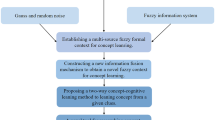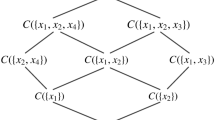Abstract
A rule is an effective representation of knowledge in formal concept analysis (FCA), which can express the relations between concepts. One of the main research directions of FCA is to develop rule-based classification algorithms. Rule-based algorithms in FCA lack effective methods for analyze their generalization capability, which can provide an effective learning guarantee for the algorithm. To solve this problem and effectively improve the classification performance of rule-based algorithms in terms of speed and accuracy, this paper combines formal concept analysis with online learning theory to design an online rule fusion model based on FCA, named ORFM. First, the weak granular decision rule is proposed based on rule confidence. Second, the purpose of each iteration is to reduce the difference between the prediction rules extracted from the ORFM and the weak granular decision rules as much as possible so that the classifier model can be adjusted to the direction of the minimum regret growth rate, and the regret growth rate is 0 under the ideal state at the end of iteration. Third, it is proven that the regret of ORFM has an upper bound; that is, in an ideal state, the regret growth rate decreases rapidly with the increase in the number of iterations, eventually making the regret of the model no longer grow. This provides an effective learning guarantee for ORFM. Finally, experimental results on 16 datasets show that ORFM has better classification performance than other classifier models.


Similar content being viewed by others
Explore related subjects
Discover the latest articles, news and stories from top researchers in related subjects.References
Wille R (1982) Restructuring theory: an approach based on hierarchies of concepts. Ordered Sets Reidel 83:445–470
Ganter B, Wille R (1999) Formal concept analysis: mathematical foundations. Springer, Berlin
Carpineto C, Romano G (1996) A lattice conceptual clustering system and its application to browsing retrieval. Mach Learn 24(2):95–122
Nguyenp PHP, Corbett D (2006) A basic mathematical framework for conceptual graphs. IEEE Trans Knowl Data Eng 18(2):261–271
Liu Y, Kang XP, Miao DQ et al (2019) A knowledge acquisition method based on concept lattice and inclusion degree for ordered information systems. Int J Mach Learn Cybern 10(11):3245–3261
Guo XR, Liu AJ, Li X et al (2020) Research on the intelligent fault diagnosis of medical devices based on a dematel-fuzzy concept lattice. Int J Fuzzy Syst 5:1–16
Tu XD, Wang YL, Zhang ML et al (2016) Using formal concept analysis to identify negative correlations in gene expression data. IEEE/ACM Trans Comput Biol Bioinform 13(2):380–391
Zou CF, Zhang DQ, Wan JF et al (2017) Using concept lattice for personalized recommendation system design. IEEE Syst J 11(1):305–314
Sampath S, Sprenkle S, Gibson E et al (2007) Applying concept analysis to user-session-based testing of web applications. IEEE Trans Softw Eng 33(10):643–658
Li JH, Mei CL, Wang JH, Zhang X (2014) Rule-preserved object compression in formal decision contexts using concept lattices. Knowl-Based Syst 71:435–445
Li LJ, Mi JS, Xie B (2014) Attribute reduction based on maximal rules in decision formal context. Int J Comput Intell Syst 7(6):1044–1053
Shao MW, Leung L, Wu WZ (2014) Rule acquisition and complexity reduction in formal decision contexts. Int J Approx Reason 55(1):259–274
Wei L, Liu L, Qi JJ et al (2020) Rules acquisition of formal decision contexts based on three-way concept lattices. Inf Sci 516:529–544
Yang HZ, Yee L, Shao MW (2011) Rule acquisition and attribute reduction in real decision formal contexts. Soft Comput 15(6):1115–1128
Zhang XY, Wei L, Xu WH (2016) Attributes reduction and rules acquisition in an lattice-valued information system with fuzzy decision. Int J Mach Learn Cybern 8(1):135–147
Li JH, Mei CL, Lv YJ (2011) Knowledge reduction in decision formal contexts. Knowl-Based Syst 24(5):709–715
Li JH, Wei L, Zhang Z et al (2020) Concept lattice theory and method and their research prospect. Pattern Recognit Artif Intell 33(7):619–642
Chen JK, Mi JS, Xie B et al (2021) Attribute reduction in formal decision contexts and its application to finite topological spaces. Int J Mach Learn Cybern 12(1):39–52
Sêrgio MD, Newton JV (2017) A methodology for analysis of concept lattice reduction. Inf Sci 396:202–217
Shao MW, Leung Y, Wang XZ et al (2016) Granular reducts of formal fuzzy contexts. Knowl-Based Syst 114:156–166
Qin KY, Lin H, Jiang Y (2020) Local attribute reductions of formal contexts. Int J Mach Learn Cybern 11(1):81–93
Wang Z, Wei L, Qi J et al (2020) Attribute reduction of SE-ISI concept lattices for incomplete contexts. Soft Comput 20(1):1–16
Antoni L, Cornejo ME, Medina J et al (2020) Attribute classification and reduct computation in multi-adjoint concept lattices. IEEE Trans Fuzzy Syst 99:1–1
Wu WZ, Leung Y, Mi JS (2009) Granular computing and knowledge reduction in formal contexts. Trans Knowl Data Eng 21(10):1461–1474
Li JH, Mei CL, Lv YJ (2011) A heuristic knowledge-reduction method for decision formal contexts. Comput Math Appl 61:1096–1106
Yan EL, Yu CG, Lu LM et al (2021) Incremental concept cognitive learning based on three-way partial order structure. Knowl-Based Syst 5:106898
Zou CF, Deng HF, Wan JF et al (2018) Mining and updating association rules based on fuzzy concept lattice. Future Gener Comput Syst Fgcs 82:698–706
Zou LG, Zhang ZP, Long J (2015) A fast incremental algorithm for constructing concept lattices. Expert Syst Appl 42:4474–4481
Shi Y, Mi YL, Li JH et al (2021) Concept-cognitive learning model for incremental concept learning. IEEE Trans Syst Man Cybern Syst 51(2):809–821
Xu WH, Pang JZ, Luo SQ (2014) A novel cognitive system model and approach to transformation of information granules. Int J Approx Reason 55(3):853–866
Niu JJ, Chen DG, Li JH et al (2022) A dynamic rule-based classification model via granular computing. Inf Sci 584:325–341
Xu WH, Li WT (2016) Granular computing approach to two-way learning based on formal concept analysis in fuzzy datasets. IEEE Trans Cybern 46(2):366–379
Xu WH, Guo DD, Qian YH, Ding WP (2022) Two-way concept-cognitive learning method: a fuzzy-based progressive learning. IEEE Trans Fuzzy Syst. https://doi.org/10.1109/TFUZZ.2022.3216110
Guo DD, Jiang CM, Sheng RX, Liu SS (2022) A novel outcome evaluation model of three-way decision: a change viewpoint. Inf Sci 607:1089–1110
Yuan KH, Xu WH, Li WT, Ding WP (2022) An incremental learning mechanism for object classification based on progressive fuzzy three-way concept. Inf Sci 584:127–147
Kivinen J, Smola AJ, Williamson RC (2004) Online learning with kernels. IEEE Trans Signal Process 52(8):2165–2176
Crammer K, Dekel O, Keshet J et al (2006) Online passive-aggressive algorithms. J Mach Learn Res 7(3):551–585
Tibshirani R (2011) Regression shrinkage and selection via the lasso: a retrospective. J Royal Stat Soc: Ser B (Stat Methodol) 73(3):267–288
Langford J, Li L, Zhang T (2009) Sparse online learning via truncated gradient. J Mach Learn Res 10(2):777–801
Duchi J, Singer Y (2009) Efficient online and batch learning using forward backward splitting. J Mach Learn Res 10(18):2899–2934
Shwartz S, Singer Y, Srebro N et al (2011) Pegasos: primal estimated sub-gradient solver for SVM. Math Program 127:3–30
Bubeck S, Eldan R, Lee YT (2016) Kernel-based methods for bandit convex optimization. ACM STOC pp.72–85
Zhang L, Liu TY, Zhou ZH (2019) Adaptive regret of convex and smooth functions. In Proceedings of the 36th ICML pp.7414-7423
Zhang L, Lu S, Zhou ZH (2018) Adaptive online learning in dynamic environments. Adv Neural Inf Process Syst 31:1323–1333
Acknowledgements
This work was supported by the National Key R &D Program of China (2020YFB1707802) and National Natural Science Foundation of China (No. 12071131).
Author information
Authors and Affiliations
Corresponding author
Additional information
Publisher's Note
Springer Nature remains neutral with regard to jurisdictional claims in published maps and institutional affiliations.
Rights and permissions
Springer Nature or its licensor (e.g. a society or other partner) holds exclusive rights to this article under a publishing agreement with the author(s) or other rightsholder(s); author self-archiving of the accepted manuscript version of this article is solely governed by the terms of such publishing agreement and applicable law.
About this article
Cite this article
Zhang, X., Chen, D. & Mi, J. Online rule fusion model based on formal concept analysis. Int. J. Mach. Learn. & Cyber. 14, 2483–2497 (2023). https://doi.org/10.1007/s13042-023-01777-x
Received:
Accepted:
Published:
Issue Date:
DOI: https://doi.org/10.1007/s13042-023-01777-x




